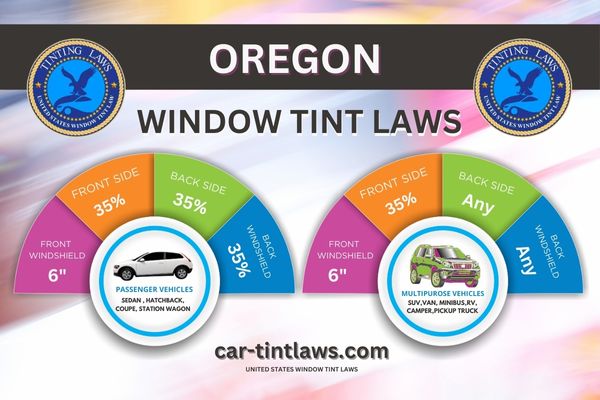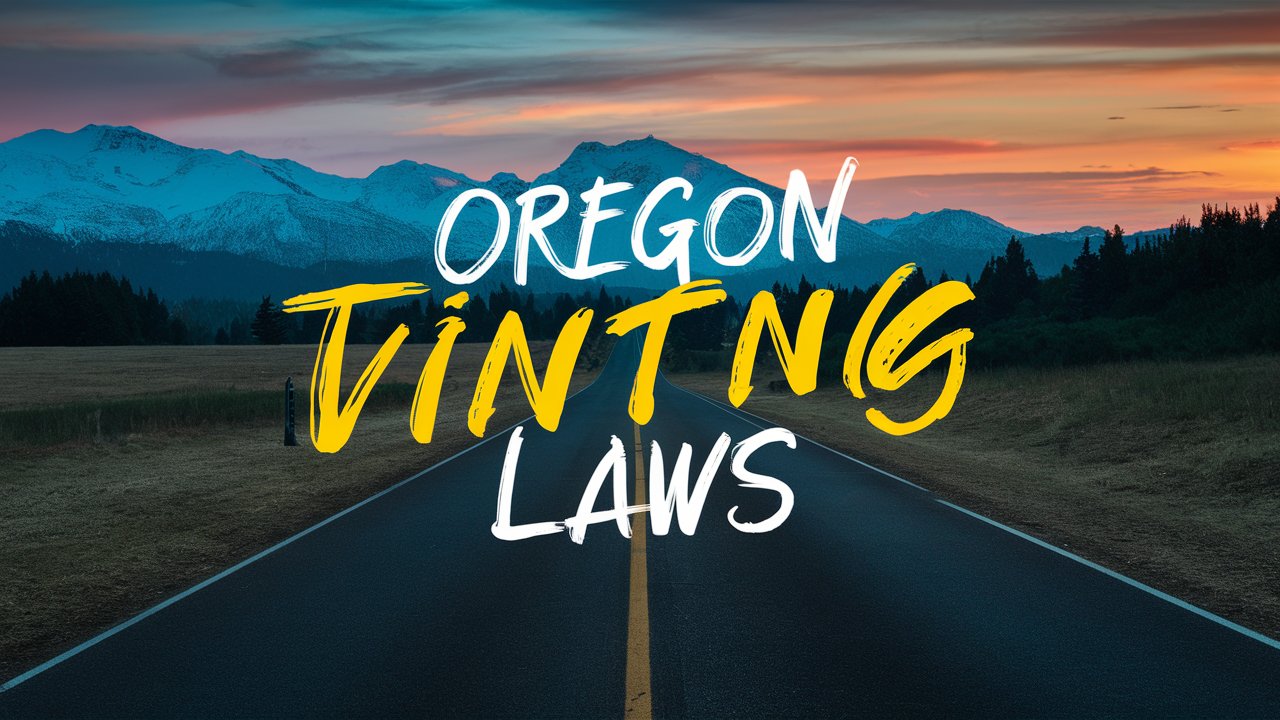When you’re thinking about window tinting for your vehicle in Oregon, understanding the specific legal requirements is crucial to avoid potential fines and hassles.
For example, were you aware that your sedan’s side and rear windows must permit more than 35% light transmission?
While SUVs and vans have greater flexibility with back side windows, all vehicles must comply with strict reflectivity limits on front side windows.
Interested in learning about other detailed regulations and how to guarantee your car’s compliance?
There’s more to discover that could help you save both time and money.
Window Tint Darkness in Oregon
When it comes to window tint darkness in Oregon, you need to know the specific requirements for different vehicle types.
For sedans, the side windows and rear windows must allow more than 35% of light to pass through.
However, SUVs and vans have more flexibility, with no specific darkness restrictions for back side windows, although their rear windows must still permit over 35% light.
Tint darkness for sedans:
- Windshield: Non-reflective tint is allowed on the top 6 inches of the windshield.
- Front Side windows: Must allow more than 35% of light in.
- Back Side windows: Must allow more than 35% of light in.
- Rear Window: Must allow more than 35% of light in.
Tint darkness for SUV and Vans:
Front and Rear Windows (SUVs and Vans): Must allow more than 35% of light in
Back Side Windows (SUVs and Vans): Any shade can be used
Window Tint Reflection in Oregon
When it comes to window tint reflection in Oregon, it’s important to understand that both sedans and SUVs/vans must adhere to specific regulations.
For front side windows, the tint can’t exceed 13% reflection, ensuring that visibility and safety are maintained for all vehicle types.
This helps reduce glare and heat inside the car while complying with state laws.
Tint reflection for sedans:
- Front Side windows: Must not be more than 13% reflective.
- Back Side windows: No specific restrictions mentioned.
Tint reflection for SUV and vans:
- Front Side windows: Must not be more than 13% reflective.
- Back Side windows: Must not be more than 13% reflective.
Other Oregon window tint rules and regulations
- Side Mirrors: No restrictions.
- Restricted Colors: In Oregon, all tint colors are permitted.
- Certificates: Manufacturers of film need to certify the film they sell in the state. Ask your dealer if they are using certified film.
- Stickers: The sticker/label of compliance to identify legal tinting is required between the film & glass on each tinted window.
- Medical Exceptions: Oregon permits medical exemptions for special tint. For more details about the specific terms of the exemption, consult Oregon state law.
- Penalties: Maximum fine for violating tint regulations in Oregon can vary, but it can be up to $360 for non-compliance. Make sure to adhere to the rules to avoid fines and maintain safe driving conditions.

Medical Exemptions for Window Tint Rules in Oregon
In Oregon, you can qualify for a medical exemption to window tint rules by providing signed documents from a licensed physician or optometrist.
These medical exemptions allow for lower light transmittance on your vehicle’s windows under specific conditions.
To obtain an exemption, you need to submit signed documents such as an affidavit, a prescription, or a letter from your practitioner on official letterhead.
This documentation must detail the medical necessity for darker window tinting.
It’s important to understand that these medical exemptions are in place to help individuals with specific health conditions that are adversely affected by sunlight.
Once you have the necessary signed documents, you should keep them in your vehicle at all times to show compliance with Oregon’s window tint rules.
Oregon Window Tint Ticket Cost
Non-adherence with window tint laws in Oregon can result in ticket costs averaging around $350 in cities like Portland.
To avoid these fines, it’s essential to verify your vehicle’s window tint adheres to state regulations.
Oregon law prohibits red, green, and amber tint films, and failing to comply with these rules can lead to hefty fines imposed by law enforcement.
If you’re pulled over and can’t provide a tint certificate to prove compliance, immediate meter testing is recommended.
Keeping proof of insurance and documentation of your tint’s legality in your vehicle can help prevent citations.
This documentation demonstrates your dedication to following Oregon’s window tint laws, potentially saving you from those costly tickets.
Oregon DMV Contact Information
For any questions about window tint laws in Oregon, you can contact the Oregon DMV at 503-945-5000.
The DMV provides information on legal tint limits, specific regulations, and requirements.
Additionally, you can visit their website for detailed guidelines or use email communication options for further assistance.
DMV Office Locations
When you need DMV services in Oregon, you’ll find multiple office locations statewide to assist with driver’s licenses, vehicle registration, and more.
Understanding Oregon’s window tinting laws is essential, and your local DMV office is a valuable resource for confirming your vehicle complies with state law.
Each office provides a range of services, including vehicle inspections, title transfers, and license renewals, making it convenient to handle your various needs in one place.
To find the nearest DMV office locations, check the Oregon DMV website.
This site offers detailed information about addresses, specific office hours, and the services available at each location.
Some offices may even have self-service kiosks, saving you time for certain transactions.
Make sure to verify if an appointment is required for your visit, as not all services may be available on a walk-in basis.
Whether you’re updating your vehicle registration or seeking guidance on window tinting laws, the Oregon DMV’s office locations are equipped to help.
By utilizing these resources, you can confirm your vehicle adheres to state law and maintain compliance with all regulations.
Contact Phone Numbers
If you need to contact the Oregon DMV, dialing (503) 945-5000 will connect you to their general inquiries line.
This number is your go-to for a wide range of DMV-related questions, making sure you have access to all the information you need.
Whether you’re looking for details on vehicle registration, driver’s licenses, or title and registration matters, the Oregon DMV is equipped to provide prompt assistance.
For specific inquiries regarding vehicle registration, you can reach the DMV by phone at (503) 945-5001.
This line is dedicated to helping you navigate the process, making sure your vehicle is properly registered.
If your questions pertain to your driver’s license or ID card, you should dial (503) 945-5000.
The DMV representatives will guide you through the requirements and steps necessary to obtain or renew your license.
For those needing help with title and registration issues, (503) 945-5000 is also the number to call.
The DMV staff can assist you with transferring ownership, updating records, and any other title-related concerns.
By calling these numbers, you can guarantee your DMV transactions are handled efficiently and correctly, making your experience as smooth as possible.
Email Communication Options
Reaching out to the Oregon DMV via email can be a highly efficient way to resolve your inquiries and obtain necessary information.
If you’re looking for convenience and quick resolutions, email communication with the Oregon DMV might be your best bet.
You can use email to contact the Oregon DMV for various specific services, whether it’s about window tinting laws, vehicle registration, or driver’s license issues.
The Oregon DMV provides clear contact information on their official website, making it easy for you to find the right email address for your specific needs.
By using email communication, you can streamline your processes and often receive timely responses, which can save you a trip to the DMV office or a long wait on the phone.
To make certain you get the most accurate and relevant information, be certain to include all necessary details in your email.
This could include your vehicle identification number (VIN), driver’s license number, or any other pertinent information related to your query.
By utilizing email communication, you become part of a more efficient and modern approach to handling DMV-related issues, making the entire experience smoother and more accessible for everyone.
References
Oregon Department of Transportation: Frequently asked questions about window tinting (.pdf file)
Oregon Department of Transportation: Vehicle Equipment Standards (see under FAQ – Windows)
Frequently Asked Questions
What Is the Darkest Tint Legal in Oregon?
You’re wondering about the darkest tint legal in Oregon, right? According to vehicle tint laws,
Oregon tint regulations allow window tint options with tint darkness limits set at 35% VLT. Legal tint percentages guarantee compliance and safety.
How Much Is a Tint Ticket in Oregon?
Isn’t it a coincidence you’re asking about tint tickets? In Oregon, you’ll face a fine amount around $350 for illegal tint.
Verify your tint percentage complies, and keep documentation handy. Otherwise, expect inspections, potential exemptions, or even tint removal.
How Dark Is 35 Window Tint?
A 35 window tint allows 35% of light to pass through, balancing tint visibility, heat reduction, and UV protection.
It addresses privacy concerns without compromising safety. The installation process is straightforward, making it a popular choice.
What Is the Darkest Legal Tint You Can Get?
Did you know that 35% tint can reduce up to 40% of heat?
The darkest legal tint percentage you can get balances car customization with visibility concerns, adhering to legal restrictions while providing significant heat reduction.
Conclusion
Understanding and following Oregon’s window tinting laws is essential to avoid fines and legal issues.
Make sure your vehicle’s tint allows more than 35% light transmission for front and side windows, and check reflectivity restrictions.
For SUVs and vans, back side windows have no specific darkness limitations.
Adhering to these regulations is like driving on a clear road—smooth and trouble-free.
For more details or questions, contact the Oregon DMV and consult the tint law references.
